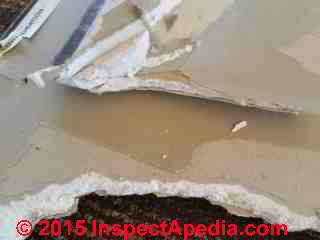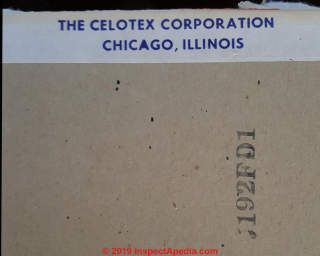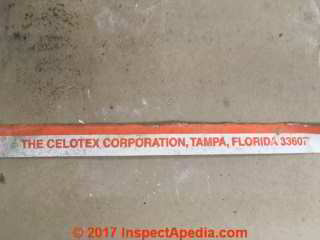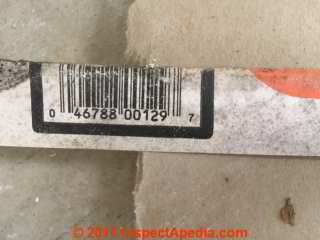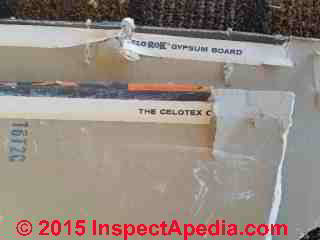 Celotex® Drywall / Wallboard Asbestos?
Celotex® Drywall / Wallboard Asbestos?
- POST a QUESTION or COMMENT about this article topic.
Drywall / gypsum board products made by the Celotex corporation.
This article discusses how to identify Celotex drywall or wallboard products and answers questions about possible asbestos content in some Celotex wall and ceiling covering wallboard, drywall, gypsum board.
This article series assists building buyers, owners or inspectors who need to identify asbestos materials (or probable-asbestos) in buildings by simple visual inspection.
InspectAPedia tolerates no conflicts of interest. We have no relationship with advertisers, products, or services discussed at this website.
- Daniel Friedman, Publisher/Editor/Author - See WHO ARE WE?
Celotex™ Gypsum Board (drywall) products & asbestos content
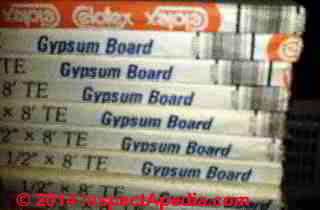
Here in order of age with most-recent first, we illustrate various versions of Celotec gypsum board or drywall and discuss wheher or not it's likely to contain asbestos.
[Click to enlarge any image]
Reader Question: asbestos in 1999-2004 Celotex Gypsum Board (drywall) 4X8 panels?
5/21/2014 Jesse said:
I am buying a house that has unused Celotex Gypsum Board (drywall) 4X8 panels in the basement... the owner has offered to leave them for me to use when I finish the basement, but I don't know if they contain asbestos and can't find an answer online.
Reply:
Jesse if you refer to celo.rock gypsum panels, some of those may indeed contain asbestos but ...
Use the CONTACT link found at the bottom of any InspectApedia web page to send me sharp photos of both sides and an edge of the product and of any stampings or markings and I can comment further.
On receipt of photo (above) This looks like a quite recent tapered edge product. If so it would not be expected to contain asbestos. Do you know when it was bought?
Reader follow-up:
The gentleman I'm buying it from says it is 10-15 years old... so '99-'04 would be my best guess. The house was built in '9.. so definitely bought after then.
Reply:
One would not expect find asbestos in any gypsum board made as recently as 1999 or later.
1978 Celotex® Drywall with the UPC # 0 46788 00129 7 was tested to confirm no asbestos content
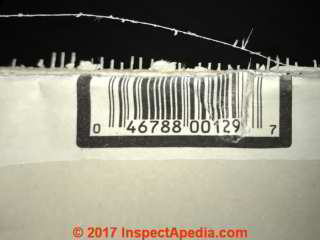 Above / left: another photo of fiber-reinforced drywall from Celotex, provided by reader T.R. by private email 2017/11/08
.
Above / left: another photo of fiber-reinforced drywall from Celotex, provided by reader T.R. by private email 2017/11/08
.
[Click to enlarge any image]
The reader reports that the drywall with the Celotex drywall product UPC # 0 46788 00129 7 shown here was in home constructed in the U.S. in 1978.
So unless the home was renovated or modified later, this Celotex board would date from 1978 or a bit earlier.
The fiberglass fibers at the upper edge of the drywall are reported to be a mesh tape that was used on that drywall seam. (I thought that fiberglass mesh drywall tape was not in use until the 1980's - Ed.].
OPINION: based on the construction date of the home alone, and if no asbestos-content tests have been performed, it would be prudent to treat this drywall as presumed to contain asbestos but chances are it's not an asbestos-containing product.
After Celotex reorganized in 1997, BPB PLC of the United Kingdom bought Celotex’s ceiling products and gypsum wallboard operations in 2000.
Current gypsum insulating boards such as Celotex Saint-Gobain Plasterboard Insulation and possibly other Celotex Saint-Gobain sheathing products contain long fiberglass fibres and polyester polyols (produced from recycled plastics such as PET bottles) but would not be expected to contain asbestos.
More details are at CELOTEX HISTORY & PRODUCTS.
The company's current products include rigid polyisocyanurate (PIR) foam boards bonded to plasterboard, for use as insulating dry lining for internal wall applications in existing domestic and non-domestic buildings.
The reader T.R. reports that he has ordered an asbestos test for this material. The sample test results were negative for Asbestos using the EPA 600 test. - private email, anon to DF, 2017/11/08
Regarding the Florida reader's question above, sorry I can't date the drywall from the data given, though Celotex might be able to do so from the bar code or labeling details.
Also I see what looks like a bit of mold on your drywall.
If you haven't done so, a thorough inspection by a competent home inspector can help you set priorities of attention for both further exploration of the home and for its repairs.
For example, the asbestos hazard from drywall that's in place in the building may be trivial (so long a you avoid dusty demolition methods) while a large moldy drywall reservoir may be more dangerous. And there may be other completely-different topics that need attention, focusing first on
- Dangerous conditions
- Damage that is rapid, ongoing, and costly
- Disfunctional but needed systems like unreliable heat, electrical wiring, &c.
Reader Question: Does this 1968-era Celo-Rok® Gypsum board contain asbestos?
I was so happy to locate your site. We are remodeling our inherited mom's house and have a whole lot of drywall to replace. We really need to find out if it contains asbestos. I think I located the name of it on your site but it says 'May contain asbestos'.
I have attached a couple of pictures in hopes that you could help identify and determine for us.
The drywall is Celotex Celo-Rok® gypsum board.
Thank you so much for any help you can provide. - Anon [by private email] 19 Sept 2015
Reply:
 Aside from product labeling and visual appearance, it would be most helpful if we knew the age of the home and age of the wallboard or about when it was installed.
Aside from product labeling and visual appearance, it would be most helpful if we knew the age of the home and age of the wallboard or about when it was installed.
Certainly Celo-Rok products from the 1940's were advertised as containing asbestos in some of that product line. However your photographs, the paper taping edging on the drywall panels, and the blue ink numeric stamp all look to me like much more modern products than those from the 1940's.
Celotex Celo-Rok® gypsum products were widely sold in the 1940's. However from my reading of the advertised properties of Celotex products (from 1943) it is clear that the company did not explicitly name asbestos as an ingredient in all of its sheathing products.
In addition to the 1943 Celotex advertisement cited in this article, I note that an advertisement for books on asbestos cites and quotes a 1947 Celo-Rok product catalog produced by the Celotex Corporation [shown at left] that refers to "Wood or Asbestos Shingles" (the latter would have properly been called asbestos-cement shingles) as a roof covering beneath which a Celotex Celo-Rok roofing panel might be applied.
The use of the word "asbestos" in referring to roof shingles is perhaps a source of confusion about asbetos as an ingredient in Celo-Rok®.
Similarly, "How You Can Build Better Homes at Lower Cost", from the same era cites:
Important contributions to "Economy Home" construction are
the new types of patented fasteners specially developed for
applying wood or asbestos shingles directly to Celotex Insulating Sheathing. ...
One section of Glen Oaks Village in Bellerose,
Long Island, N.Y., built by Gross-Morton of Jamaic or L. I., N. Y. There are 3800 apartments in
this huge, beautiful garden-type development.
Celotex insulating Sheathing used throughout.
C. A. Hemphill Associates, Evanston, Illinois, used
Celotex Insulating Sheathing on these fine homes
in Forest Glen subdivision, Winnetka, III. - retrieved 21 Sept 2015 original source: http://archive.org/stream /HowYouCanBuildBetter HomesAtLowerCost/HowYouCanBuildBetterHomesAtLowerCost_djvu.txt
In the 1940's Celotex produced and marketed "Celo-Rok Anchor Lath" as a substitute for traditional wood lath in wall plastering applications. The company produced a "cane-board" lath product as well.
These texts do not cite asbestos in the sheathing or lath product itself.
I suspect that your gypsum wallboard does not contain asbestos, though I do not know that for a fact. My reasoning is that at least into the 1960's the use of asbestos in building products was considered a positive feature as it added both strength and fire resistance. It was common for a manufacturer to include asbestos and its properties in product literature and in product advertisements.
Bottom line: to know for certain if your specific Celo-Rok wallboard contains asbestos you'd need to send a sample to a certified asbestos testing lab.
See ASBESTOS TESTING LAB LIST
As it's quite inexpensive, and as it could make a significant difference in the cost in an extensive renovation work where all drywall is being removed, I would have a lab test performed to confirm the presence or absence of asbestos in your 1960's vintage Celo-Roc. That's because:
- We have not found unequivocal data clearly stating the presence or absence of asbestos in interior gypsum board produced with the Celo-Roc brand
- If you found asbestos in a dust-creating material that was going to be removed during extensive demolition and that couldn't be removed with practically no debris and dust production, an asbestos-dust-containment job will be much more costly than straightforward demo of asbestos-free drywall.
If you take that action (about $50. U.S.) you can send me the bill and in any case I ask that you keep us informed of a test result as what you learn will help other readers.
Question: does this 1963 Celotex Gypsum Board Contain Asbestos?
Trying to determine if this Celotex drywall contains asbestos. Home built in 1963 in Wisconsin.
Reply:
Anon, Celo-Rok products from the 1940's were advertised as containing asbestos in some of that product line.
In the 1960s some (not most) drywall itself contained asbestos and asbestos was widely used in drywall joint compound.
In addition to the Celotex Corporation blue printing on the edge of your drywall I see a stamp, partly illegible, ending in 192FD1 that might be a production date code;
I'd assume from your note that unless your building underwent subsequent remodeling, renovation, or additions, your drywall was probably manufactured prior to 1963 when your home was built.
Beyond that general guess you'd need to have a sample of the gypsum board tested for asbestos.
See
ASBESTOS TESTING LAB LIST if you decide to have a sample of this Celotex gypsum board tested for asbestos, and if you do so, please let us know the result as that'll help other readers.
Question: Age & Asbestos Content of Celotex drywall made in Tampa Florida ?
I began renovating our basement and removed the old celotex drywall. I am wondering if it is possible to date it. I have attached a picture of the label.
Any help would greatly be appreciated. We just purchased the house to find a number of issues hidden behind the drywall.
We are trying to determine if the previous owner installed the drywall and therefore knew about the foundation damage. I will try the company. - Anonymous by private email 2017/03/03
Celotex Drywall Asbestos History & Research
- [1] Celotex 1973 Celotex Acoustical Systems catalog, January 1973
- [2] Celotex Home Building Materials, 1947 catalog, lists: Cane fiber products: Celotex sheathing, Celotex insulating lath (board), Celotex interior finish, Celo-Siding, Celo-Rok Gypsum products [may contain asbestos]: Celo-Rok anchor lath, Celo-Rock wallboards, Celo-Rok plasters, and Other Products: Celotex rock wool, Celotex roofing, Celotex hard boards, Celotex Cemesta, Celotex Corporation, Chicago IL
- [3] Celotex Insulating Cane Board, product catalog
- [4] Celotex Building Insulating Materials, 1948 Catalog, listing: Cemesto insulation, Cemesto roof decks, Cemesto exterior wall coverings, Cemesto interior wall coverings [we believe the Cemesto lines refer to cement-asbestos products - ed. ]
- [5] Celotex Sound Conditioning, 1948 Catalog, including perforated asbestos board sheets
- Celotex ceiling products division was purchased by Ceiling Products & Gypsum Wallboard (BPB) of the U.K. beginning in 1999
- Celotex roofing products division was purchased by Certainteed Corporation (Valley Forge PA) beginning in 1999
- [11] CELOTEX HISTORY [UK], [PDF] Celotex Insulation Specialists, web search 6/30/12, original source: http://www.celotex.co.uk/celotex-history [Copy on file as Celotex_History_UK.pdf ]
- Also seeReferences or Citations at the end of this page
...
Reader Comments, Questions & Answers About The Article Above
Below you will find questions and answers previously posted on this page at its page bottom reader comment box.
Reader Q&A - also see RECOMMENDED ARTICLES & FAQs
On 2019-12-28 by (mod) -
Toots
Sometimes we can get an "earliest possible" date by noting patent numbers or other text on drywall stamps and labels.
Ultimately if you face a significant "asbestos-suspect" demolition cost or hazard it makes sense to simply have the material tested.
On 2019-12-26 by tootsie deadbrain
how can i identify celotex drywall for asbestos with the numbers that are stamped on the back of the drywall because the identifying label on the edges is gone?
On 2019-03-04 by (mod) -
Steve I can't say for certain but the "2022 "suffix in Drywall marked Celotex 2022 may refer to a patent expiration date of 2022 for fibrglass-reinforced gypsum board made by that company.
You took some precautions and have by now cleaned-up; if you want to be more certain about dust management you could do additional damp wiping and HEPA vacuuming - don't use a normal household or shop vac or you will aerate small particules (including any abestos if that were present).
DO let me know what your test results indicate and if you can attach photos of the drywall ID markings that would be valuable help for other readers as well as for further research.
On 2019-03-04 by Steve
I am doing a demo of a room probably built in 1977, most of the house had been remodeled in 2017 and I am installing sound proof ceilings in the basement for my Father in Law to live. The drywall board said Celotex 2022 or 2122,
does anyone know if this is a product I should be concerned about? I wore a dust mask, a full suit and gloves for most of the demo but I know they recommend full respirator for asbestos. I will have it tested but was hoping the numbers would give me some info.
On 2019-01-25 by (mod) - tape over or patch the wall damaged drywall to be safest
Rola:
My suggestion is to tape over or patch the wall damage. It's so minor that there is very little probability of a detectable gypsum dust hazard much less asbestos from those dings, but certainly we don't want to be dusting the baby with drywall dust.
On 2019-01-25 by Rola
Hello, I live in a building that was built in 1910.
However was recently renovated within the last 15 yearsm , in new york city.
I noticed some holes and peels in the walls ( which appear to be drywalls) since they are hallow when I knock on them .
Two of the holes are next to the babys crib. I noticed in the paint peel some glittering ( am not sure whether it is asbestos or fiber glass.
When I woke the floor for cleaning I noticed some white fibers that appeared solid to me.
Please advise.
IMAGE LOST by older version of Clark Van Oyen’s useful Comments code - now fixed. Please re-post the image if you can. Sorry. Mod.
On 2018-12-20 by (mod) -
Anon:
My best information on your question is in the article above.
Please take a look at that data and let me know if any of that is unclear.
Watch out: I note in your photo what looks like a metal flue - depending on its materials and use and fire-clearance rating that installation could be too safe: about an inch or less from combustible wood and from paper-coated drywall, possibly with additional heat due to covering with mineral wool insulation.
On 2018-12-20 by (mod) -
Re-posting question received by private email:
Anonymous asked:
Hi, I recently purchased a home and I was in the attic blowing in insulation and I seen Celotex gypsum board on the ceiling and wanted to know if you could identify it if it had asbestos or not here’s a picture. Home was build in 1975 in Kansas.
IMAGE LOST by older version of Clark Van Oyen’s useful Comments code - now fixed. Please re-post the image if you can. Sorry. Mod.
On 2018-03-27 by IH
Do you have any information on possible asbestos content of Celotex gypsum board with the following UPC?
0 46788 00118 1
On 2018-01-22 by Ben Watson
Hello there,
I am im search of an age to my drywall.
I saw a consumer posted a similar question as they found a foundation issue behind their wall. This exact scenario happened to me and I have to prove they installed this drywall and knew about the damage.
The entire foundation wall is destroyed and has to be replaced, hopefully not on my dime. Any help would be GREATLY appreciated!
IMAGE LOST by older version of Clark Van Oyen’s useful Comments code - now fixed. Please re-post the image if you can. Sorry. Mod.
On 2017-11-08
by Ron
I took out a wall in my house and found this Celotex drywall was used.
The house was built in 1978 and this drywall was used for a closet that was put in after the house was built. It was not original to the home. It had to be sometime between after the House was built until we bought it in 2003. Should I be concerned?...
...
Continue reading at CELOTEX CemestO BOARD HOMES or select a topic from the closely-related articles below, or see the complete ARTICLE INDEX.
Or see these
Recommended Articles
- ASBESTOS-SUSPECT CEILING COVEROVER
- ASBESTOS-FREE CEILING TILES
- ASBESTOS TESTING LAB LIST f certified asbestos testing labs
- CEILING TILE MATERIALS
- CELOTEX ASBESTOS PRODUCTS
- CELOTEX CemestO BOARD HOMES
- CELOTEX DRYWALL ASBESTOS
- CELOTEX HISTORY & PRODUCTS
- CELOTEX: IDENTIFY Celotex® Insulating Board and Fiberboard Products
- FIBER CEMENT SIDING - home
- FIBERBOARD SHEATHING IDENTIFICATION
- POLYISOCYANURATE FOAM BOARD - more about Celotex and Dow insulating sheathing
Suggested citation for this web page
CELOTEX DRYWALL ASBESTOS at InspectApedia.com - online encyclopedia of building & environmental inspection, testing, diagnosis, repair, & problem prevention advice.
Or see this
INDEX to RELATED ARTICLES: ARTICLE INDEX to ASBESTOS HAZARDS
Or use the SEARCH BOX found below to Ask a Question or Search InspectApedia
Ask a Question or Search InspectApedia
Try the search box just below, or if you prefer, post a question or comment in the Comments box below and we will respond promptly.
Search the InspectApedia website
Note: appearance of your Comment below may be delayed: if your comment contains an image, photograph, web link, or text that looks to the software as if it might be a web link, your posting will appear after it has been approved by a moderator. Apologies for the delay.
Only one image can be added per comment but you can post as many comments, and therefore images, as you like.
You will not receive a notification when a response to your question has been posted.
Please bookmark this page to make it easy for you to check back for our response.
IF above you see "Comment Form is loading comments..." then COMMENT BOX - countable.ca / bawkbox.com IS NOT WORKING.
In any case you are welcome to send an email directly to us at InspectApedia.com at editor@inspectApedia.com
We'll reply to you directly. Please help us help you by noting, in your email, the URL of the InspectApedia page where you wanted to comment.
Citations & References
In addition to any citations in the article above, a full list is available on request.
- [13] Brian Greer, "History of Tin Ceilings", Brian Greer's Tin Ceilings, web search 6/30/12, original source: http://www.tinceiling.com/company/historytin.php
- [14] Armstrong Corporation, "Corporate History: a Historical Summary", web search 6/30/12, original source: https://www.armstrongflooring.com/corporate/corporate-history.html
- [15] "Ceilings Pressed in Time", Old House Journal, web search 6/30/12, original source: http://www.oldhousejournal.com/ceillings_pressed_in_time/magazine/1070
- [16] Steven Mlynarek, Morton Corn, Charles Blake, "Asbestos Exposure of Building Maintenance Personnel", Regulatory Toxicology and Pharmacology, 23, 213–224 (1996) ARTICLE NO. 0045, http://library.certh.gr/libfiles/PDF/GEN-PAPYR-4810-ASBESTOS-by-MLYNAREK
-in-RTAP-VOL-23-ISS-3-PP-213-224-Y-1996.pdf - [17] National Institute of Occupational Safety and Health (NIOSH) (1989). In NIOSH Manual of Analytical Methods (P. M. Eller, Ed.), Method 7400. NIOSH, Washington, DC.
- [18] U.S. Environmental Protection Agency (USEPA—Green Book) (1990). In Managing Asbestos in Place: A Building Owners Guide to Operations and Maintenance Programs for Asbestos-Containing
- [19] U.S. Department of Labor, Occupational Safety and Health Administration (USDOL) (1994). In Occupational Exposure to Asbestos: Final Rule, FR Vol. 59, No. 153:40964–41162. Materials, Report 2OT-2003. USEPA, Washington, DC.
- [20] U.S. Department of Labor, Occupational Safety and Health Administration
(USDOL) (1986). In Occupational Exposure to Asbestos: Tremolite, Anthophyllite, and Actinolite: Final Rule, FR Vol. 51, No. 119:22631–22644. - Asbestos NESHAP ADEQUATELY WET ASBESTOS GUIDANCE, EPA340/1-90-019, December 1990, U.S. ENVIRONMENTAL PROTECTION AGENCY, Office of Air Quality Planning and Standards, Stationary Source Compliance Division, Washington, DC 20460,original web source: http://www.epa.gov/region04/air/asbestos/awet.htm
- EPA ASBESTOS MATERIALS BAN: CLARIFICATION 1999
- "Handling Asbestos-Containing roofing material - an update", Carl Good, NRCA Associate Executive Director, Professional Roofing, February 1992, p. 38-43
- EPA Guidance for Controlling Asbestos-Containing Materials in buildings, NIAST, National Institute on Abatement Sciences & Technology, [republishing EPA public documents] 1985 ed., Exposure Evaluation Division, Office of Toxic Substances, Office of Pesticides and Toxic Substances, U.S. Environmental Protection Agency, Washington,D.C. 20460
- In addition to citations & references found in this article, see the research citations given at the end of the related articles found at our suggested
CONTINUE READING or RECOMMENDED ARTICLES.
- Carson, Dunlop & Associates Ltd., 120 Carlton Street Suite 407, Toronto ON M5A 4K2. Tel: (416) 964-9415 1-800-268-7070 Email: info@carsondunlop.com. Alan Carson is a past president of ASHI, the American Society of Home Inspectors.
Thanks to Alan Carson and Bob Dunlop, for permission for InspectAPedia to use text excerpts from The HOME REFERENCE BOOK - the Encyclopedia of Homes and to use illustrations from The ILLUSTRATED HOME .
Carson Dunlop Associates provides extensive home inspection education and report writing material. In gratitude we provide links to tsome Carson Dunlop Associates products and services.


